Today's post Vintage Gloves – Styles from 1900 to 1960s from VintageDancer.com.
 Can you imagine having to wear gloves every time you left the house? Even in the summer? While gloves are worn only for warmth these days, they were an absolute necessity up until the mid-twentieth century. Both of the world wars contributed to the vintage glove’s demise, as well as a new, more independent lifestyle for women.
Can you imagine having to wear gloves every time you left the house? Even in the summer? While gloves are worn only for warmth these days, they were an absolute necessity up until the mid-twentieth century. Both of the world wars contributed to the vintage glove’s demise, as well as a new, more independent lifestyle for women.
Vintage Gloves with Purpose
Prior to the 20th century, gloves could symbolized a woman’s class or in the case of gloves hide her class status. A wealthy woman’s hands were pale, smooth, thin and graceful. A working woman or homemaker’s hands were thick, rough, scarred and tan. When she wore gloves she could hide her class status, dressing well to elevate herself into a better life. As fashions began to blend the upper and lower classes together it was in the details of the glove design, material, and fit that hinted at a woman’s status.

Covered up for protection and modesty
Vintage gloves were also a protection from disease. Contagious disease was the ruin of lower and middle class families. Upper classes feared catching illnesses when out in public. Even with gloves on, there was very little touch involved, including close family members. Wearing gloves, even to greet one’s guests at home was protection from the outside world. Gloves were never removed unless a woman was eating or responding to nature. Frequent hand washing around these two activities was done before putting gloves back on. With the heighten fear of germs gloves became more than an accessory they were a necessity for a healthy life.
Finally gloves also covered the body up. Modestly was very important in clothing and dress. Especially in the early teens and twenties when gloves were one more way for a woman to remain covered while being uncovered in short sleeved dresses. To bare skin was shocking and un-lady like. Even in the evenings, for young women, where fashion allowed more flirting with exposed skin long, over-the-elbow gloves, made it possible for her arms to remain decently covered. Only shorter mid forearm length gloves could be worn during the day if her dress or blouse had long sleeves to overlap the gloves.

1922 Gordon glove ad. Department stores had counters devoted just to selling gloves!
1900-1910s Gloves
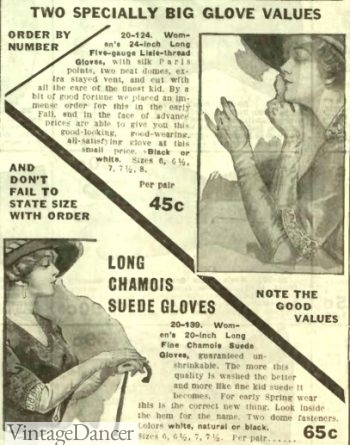
1913 Women’s full length gloves made of Lisle and Suede
In the early 1900s, vintage gloves were worn everywhere. As mentioned above the length of glove determined what other garments she was wearing. During the day kid leather, suede also called mocha and cotton lisle were worn in mid- forearm lengths. They fit tight and thin, buttoning from the wrist up to the top of the glove. Many had fine embroidery stitched into the top of the glove or all over. Fancy gloves were lined in silk and winter gloves lined in wool or fur. There were specialty gloves for wedding clothes and even driving. Gauntlet gloves were the best style for driving cars, driving horses, or other potentially dirty work. The gauntlet cuffs protected the sleeves of her dress or coat.
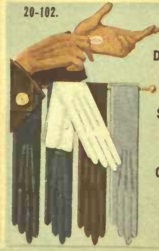
1913 glove colors
Popular colors were tan, brown, black, white, red, grey, navy blue, cream and green. Various shades of these existed to coordinate with the colors of her clothing. As colors lighted into the late teens so did glove colors. Pastels were now popular including the biggest fad for lavender. Gloves were sized based on the circumference of her palm and the arm width was adjusted accordingly. For working woman who had thick hands but skinny arms the awkward fit of her gloves was a sign of her lower class.
During the evening, longer gloves were appropriate – from 12 to 20 buttons, reaching all the way to the bicep – in kid leather, suede or silk. Gloves, lavishly decorated with lace and embroidery before, became very plain during war time. When WWI hit, supplies of leather went to the war effort and the price of gloves soared.

1909 Women’s summer and winter gloves and mittens
1920s Vintage Gloves

1920 plain leather gloves
Women continued to wear mid-forearm length gloves after the war, but they were certainly on the decline. It was also a declining trend to wear gloves all the time. The new fad for sun tanned skin meant that women didn’t need to cover up completely. In summer, gloves were hardly ever worn while winter called for warm leather or hand knit gloves. Certain occasions in semi formal dress (tea parties, visiting, traveling) called for women to wear gloves in all seasons. They could be an open mesh or light cotton for summer and leather or wool in winter. Colors were dyed to match either a dress or accessories for the upper class, or were a plain neutral color for the lower classes.

Early 1920s, white mesh gloves were idea for semi formal summer wear (Downton Abbey 2012)
Vintage gloves stayed very plain, although the Art Deco fad of the ‘20s and ‘30s set off a trend for decorating gloves with contrasting stitching and embroidered geometric patterns. Pastels and jewel tones were favorite colors. Some women continued to wear button gloves, but the gauntlet was the more stylish choice (a gauntlet is a large cuff that is wider than the glove, so only the part that covers the hand is very tight-fitting). Elasticized panels in the wrist of gloves also allowed them to be pulled on instead of buttoned.
By the late 1920s, the gauntlet glove folded down into a new cuffed glove. The cuffs were highly decorated with embroidery, contrasting fabric, knitted designs, lace edging and various shaped edges. They cuffs were quite colorful and very fun for the times. The trend for arts and crafts and Nordic designs in winter inspired a new range of lined winter gloves and mittens as well.
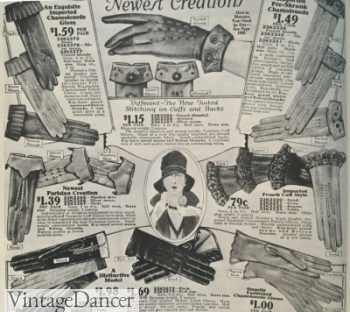
1926 Winter Gloves with turn down cuffs

1922 Long white opera gloves with formal attire
In the evenings, long opera length gloves that were over the elbow and made of silk or rayon satin were often worn with formal dresses. It was not required but the wealthier classes usually opted for this traditional look. They pulled on so the overall fit was much looser than the earlier button styles. Gloves remained on at all times unless a woman’s was doing something that could dirty her gloves such as eating, smoking or applying makeup.
1930s Vintage Gloves
For very formal wear, gloves were abandoned in the 1930s. The more skin the better was the attire of the evenings. A few exceptions were worn by top designer Schiaparelli who returned to the 20 button opera glove for some formal looks.
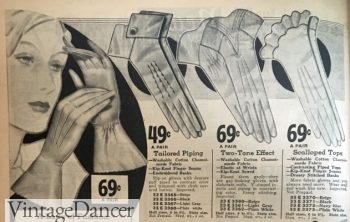
1934 gauntlet leather gloves with unique edging
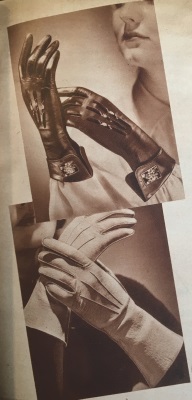
1938 Plain leather gloves

1930s hand knit gauntlet gloves with coordinating knit dress
Leather gloves continued to have their place for dressy occasions, city life, sport and manual labor but for most daily wear fabric gloves was much more practical. The fold down cuff of the late ’20s unfolded for a gauntlet cuff again with shaped edging such as scallops, petals, and embroidery. Less fancy gloves were a little shorter in leather or wool or a mix of the two with minimal decoration. During hard time these were the most affordable besides home knitted gloves.
In the summer, home made crochet gloves in white were breathable and affordable. They often matched crocheted purses, belts and hats too. The gauntlet design applied here as well.

1937 gauntlet gloves in white both fabric and crochet mesh
The color of the gloves matched the other accessories. They did not need to match the dress. To save on expense most women had black, brown and white gloves in their wardrobe with coordinating accessories. These were the most practical and neutral colors.
1940s Vintage Gloves

Ruched 1940s glove patterns
During the ‘40s, and WWII, gloves were rationed – women had to use precious ration coupons to get them, and so they became a somewhat frivolous accessory. Women worked a lot during the war, both in and outside of the home, and dress gloves were simply not practical.
Daytime dress gloves were usually made from leather or suede in dark, neutral colors like navy, tan, brown and black, although dark red and green were also used. White was also common for those who could keep them clean. The gauntlet style narrowed down to a slight taper over the mid arm and fancy cuffs, trim and decorations disappeared. Elbow-length leather or fabric gloves were worn pushed down towards the wrists for a more stylish look. This ruched effect mimicked the ruching common on women’s dresses and many purses too.

1944 simple leather gloves
Vintage gloves weren’t even necessary for evenings anymore, but women wore them more at night, sometimes attempting to make a daytime dress fancier for an evening occasion. White or ivory wrist-length kid leather gloves were a popular choice, and shirred stretch rayon in a variety of colors really amped up the glamour.

1948 white gloves for day and evening
In the 1940s, vintage gloves were coordinated to a hat, dress or suit, not necessarily to multiple accessories. Being entirely matchy matchy was something introduced in the 1950s.

1940s semi formal dress with gloves that matched hats
1950s Vintage Gloves

1953 glove choices
Gloves saw a resurgence during the ‘50s, when clothing became ultra-feminine and formal after the war. Accessories were very important, and a matching hat, bag and gloves had to perfectly finish off an outfit.

1950s short gloves

1957 short white gloves were worn with nearly every dress
Most women wore gloves when out in public during the day, especially in the first half of the decade. Daytime gloves were wrist-length in leather or suede in neutral colors or plain white. Jackie Kennedy wore wrist length white gloves for most of her public appearances. She was model for the decade as to how women should dress.
Gloves took note from all the previous decades and came in a number of other lengths, cuts and colors. The scalloped gauntlet remained common as well as long plain gloves. Button details, bows, embroidery, and ruffles adorned many day styles. Peach, pink, and baby blue were all great colors for spring.
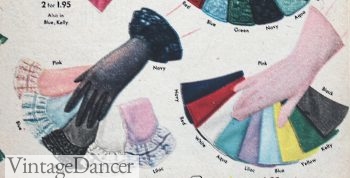
Colorful ruffle cuffed gloves
Evening gloves were usually worn too – elbow-length in satin or nylon, of course matching the dress. Big sparkly bracelets were often worn over the top. Evening gloves dyed to match a formal dress were ideal for long gloves. Alternatives were sheer net or short lace gloves in a harmonizing color.

1950s formal dress with long gloves and sparkling bracelets

My 1950s gloves collection
1960s Vintage Gloves

1964 yellow gloves add a pop of color

1964 pastel colors were in style
In the ‘60s, women didn’t feel like they had to wear gloves at all, and most didn’t for any reason. In the early years, the use of gloves was identical to the 1950s. Mostly white, short and undecorated. Longer gloves for evening were still an option.
As the years moved on there was a wave of interest in pastel color dresses so naturally gloves came in pink, yellow, blue, and green too. In fall or winter colors embraced earth tones. Light tan, moss green, black, and nude. They almost always coordinated with the dress, not the accessories. There were exceptions where a pop of colored gloves was worn to spice up an otherwise plain look.
When the mod look became popular gloves emerged with more personality. Cutouts, buttons, and contrast trim updated them from the plain old ladies style. The latest craze was for synthetic fabrics like stretchy nylon. They didn’t breath well but the light shine to them was new and very modern.
Looking at fashion pictures, by 1967, women didn’t wear gloves but they carried them in hand. They were now a fashion accessory without a purpose! By the 1970s vintage gloves were gone from fashion except in winter where they were required for warmth. Just like today dress gloves could be worn for special occasions but that was about it. Women had had enough.
Will dress gloves come back in fashion again? Only time will tell….

My 1960s mod gloves with red and blue trim
Vintage Style Gloves
Adding a pair of gloves will add that extra bit of oomph and authenticity to any outfit. Shop here for new vintage inspired gloves in all lengths and colors.
Read, comment, and share this article online : Vintage Gloves – Styles from 1900 to 1960s on VintageDancer.com.
































